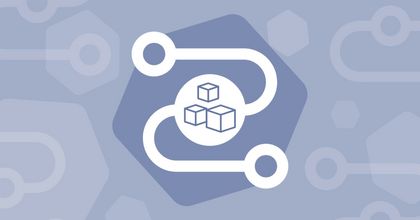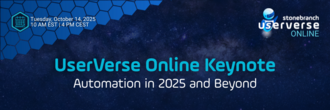Automated Kubernetes Deployment for the Modern Enterprise
Gartner predicts 90% of enterprises will use containers by 2026. Will you be prepared to automate applications within these temporary environments? Keep reading to learn how.

With business environments growing more competitive, enterprise IT organizations must operate at hyperscale to stay ahead. They need to rapidly provision and deploy containerized applications using technologies like Kubernetes, while also ensuring high availability and performance.
That's where coordinated IT automation solutions like Stonebranch Universal Automation Center (UAC) come in.
By orchestrating the deployment, configuration, and management of Kubernetes containerized applications, enterprises can achieve greater efficiencies and scale their operations to meet ever-changing business demands.
Below, we'll discuss some of the key benefits of Kubernetes automation for the modern enterprise. By the end, you’ll never have to worry about the "how" of Kubernetes again.
Growth of containers
There's no doubt that containers have taken the IT world by storm. In just a few years, they've gone from being a niche technology used by early adopters to becoming the de facto standard for application packaging and deployment.
Containers offer several advantages over traditional virtual machines, including improved resource utilization, portability, and faster deployment times. No wonder they're being adopted by enterprises at an unprecedented rate.
Gartner predicts that “90% of global organizations will be running containerized applications in production by 2026 — up from 40% in 2021. In addition, by 2026 20% of all enterprise applications will run in containers — up from fewer than 10% in 2020.” The rich configuration management capabilities of containers make them an attractive option for enterprises that are looking to modernize their application development and deployment processes.
Why they've gone mainstream
Modern enterprises look to containers for a variety of reasons, but the three most common are:
Faster application development and deployment
Containers allow developers to package all the dependencies for an application into a single image. This makes it easy to ensure consistency throughout the CI/CD pipeline; developers can confidently build, test, and deploy applications in any environment, whether on-prem or in a public cloud.
Improved resource utilization
Containers are more efficient than virtual machines, which tend to have a lot of wasted resources. By using containers, enterprises can improve their compute utilization and save money on infrastructure costs.
Greater portability
Containers can be deployed on any infrastructure, whether on-prem or in the cloud. This makes it simple for enterprises to move applications between different environments, which is helpful for both development and production.
These advantages over old-school virtualization have led to the widespread adoption of containers by most forward-thinking technology companies today.
Challenges faced when automating applications within containers
But it's not all sunshine and roses. While containers offer many benefits, they also introduce new challenges when it comes to automating the deployment and management of apps.
This is mostly because containers like Kubernetes are ephemeral, which means they can be created and destroyed very quickly. While ephemerality is one of the main benefits of containers (it allows for easy rollbacks and updates), it also makes it difficult to automate their deployment and management.
Specifically, here are some of the challenges faced when automating applications within containers:
Configuration management
With dozens of container technologies and so many moving parts, it can be difficult to manage a robust config for all the different components in a containerized application. Especially when they need to talk to each other, handle on-prem databases, and initiate workflows (this requires an advanced automation and orchestration solution, such as UAC).
Orchestration
Containers must be orchestrated to run efficiently. That means they need to be started, stopped, and scaled in a coordinated way. This can be difficult to do manually, and it's even more challenging to automate using the limited automation capabilities available in container management tools.
Security
With containers, there are new security concerns to consider, such as how to prevent containers from accessing their shared resources. Most modern container management systems generally prevent this, but it’s worth noting.
These challenges are not insurmountable, but they do require a new approach to automation. That's where Stonebranch Universal Automation Center comes in.
How to orchestrate automation in containers, along with the rest of your workloads and business processes
Achieving automation nirvana requires more than just automating the deployment and management of containers. It also requires orchestrating the automation itself.
Stonebranch Universal Automation Center is designed to help enterprises do just that. It's a coordinated solution that enables enterprises to automate their entire application development and deployment process, from start to finish.
Our Universal Agent securely transfers data to and from mainframes, on-prem databases, and cloud-native apps running on OpenShift. It also allows the simple configuration and initiation of OpenShift batch jobs using a simple YAML file.
It works by inserting an agent into your Kubernetes container environment that can communicate with other Stonebranch agents across your enterprise. This allows you to manage all automation from a single platform, regardless of differences in technology or location.
Companies using Red Hat OpenShift can add a UAC agent to a Kubernetes container directly from OpenShift, increasing integration and accelerating time to value.
What does this mean?
- Looking to connect with an external database from a Kubernetes container? No problem. Our agent can reach out to the database agent on the other side and establish a connection.
- Need to trigger a workflow in another part of the enterprise? Easy. UAC can send a message to any OpenShift host machine (without the need to install an agent on that device), which will then start the workflow.
- Trying to automate a process that spans multiple containers? We can help with that too. Our agent can coordinate with OpenShift persistent or pod storage to ensure that the process is executed correctly.
By providing a unified platform for all your automation needs, UAC makes it easy to orchestrate even the most complex containerized applications.
Start Your Automation Initiative Now
Schedule a Live Demo with a Stonebranch Solution Expert






